The top 40 OpenSim grids gained a total of 1,199 new regions over the past month, for a new record total of 15,765 regions.
The biggest growth was on OSGrid, the non-profit grid which allows people to connect regions for free — or rent them from hosting companies for as little as $10 a month. OSGrid gained 1,062 new regions.
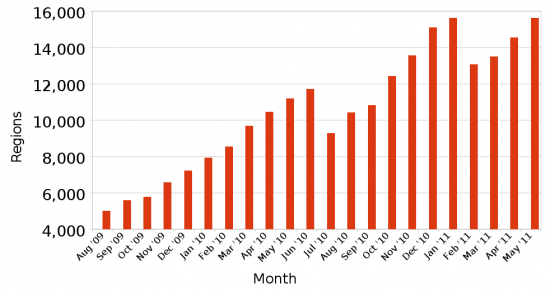
The February dip in the chart above was a result of a purge of more than 4,500 regions on the OSGrid in late January, a long-awaited housecleaning of unused region locations. OSGrid allows home-based regions and, since those regions may not be up all the time, keeps slots reserved for them — even if the owners had shut the regions down or moved them elsewhere.
In second place in terms of region growth was the cloud-based Kitely grid, with 143 new regions, for a new total of 673 regions. Kitely offers ultra-low-cost regions for occasional use, though the cloud-based pricing is not competitive for sims that see continuous high traffic. Kitely is still in beta, so regions are currently free.
The top grids did suffer a major loss this month — the 300-region Meta7 grid shut down due to legal troubles.
However, we added several new grids to our list, including Nova Grid, Gay Nations, Curiosity Grid, Savage Grid, Darkboon, DigiGrids, Slackdog Grid, and VWER Grid, among others. If there’s a public grid we’re not tracking, please email us at editor@hypergridbusiness.com.
Commercial gains
The two top commercial grids — Avination and InWorlds — led the charts in numbers of new registered users. Avination gained 3,533 new users, for a new total of 28,522. InWorldz gained 1,698 new users, for a new total of 36,962.
However, OSGrid retained its place at the top with 60,899 total registered users, adding 1,374 new users this month.
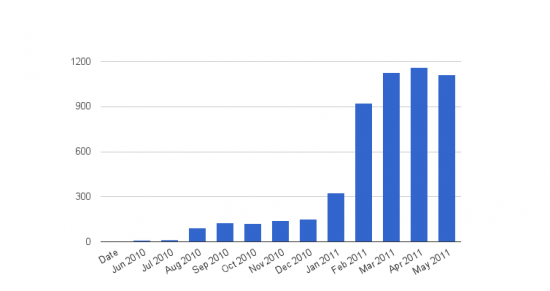
Avination retained its top position as the grid with the most active users, with a total of 8,066 users who logged in during the past 30 days. However, this was a loss of 881 active users since the same time last month.
But Avination didn’t just lose active users — it also lost a net of 49 regions since mid April, while InWorldz gained 20 regions.
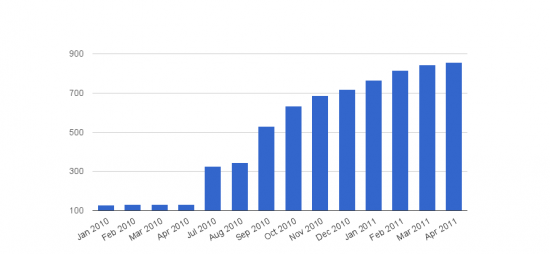
In terms of activity this month, OSGrid was in second place, with 3,498 active users, and AlphaTowne was third with 1,069 active users. InWorldz does not report active user numbers.
There are now a total of 35 grids that rent regions. (See list here under the “Single Grid” subheading.)
Cloud burst
But the big story continued to be the cloud-based Kitely service, which is integrated with Facebook and allows users to set up a new region within a couple of minutes — or upload an existing region’s backup OAR file.
In fact, many users ran out of their free beta “Kitely Credits” due to high usage — spurring Kitely CEO Ilan Tochner to top up user accounts to allow regular use to continue. One high-traffic region was The Emporium by KatiJack Studio, a place where Kitely users can pick up free trees, tables and chairs, a tea house, and even a conference facility.
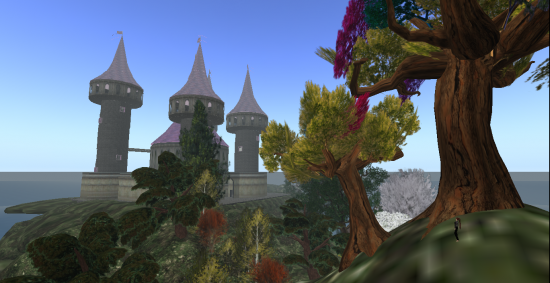
Kitely also benefited from the recent emergence of websites that distribute free or low-cost OpenSim content, since Kitely users can upload an OAR each time they create a new region, or upload individual objects by using the “Upload” feature of the Imprudence viewer. These sites include Total Avatar Shop, KatiJack Studio, OpenSim Creations, FleepGrid Shop, Nebadon 2025, and OpenSim Worlds. (Full story here.) The Faerie Castle region in the photo above, for example, is available free at OpenSim Worlds. If you have a Facebook account, you can visit it on Kitely here.
As a result of the content now available, Kitely users can outfit their regions, and their avatars, at low to no cost.
“Some users began conducting regular education and work-related activities inside their worlds,” Tochner told Hypergrid Business.
Kitely also released its Terms of Service recently, one of the least restrictive of any grid. Both mature content and children under 13 are allowed on the grid. This works because region owners can easily set access restrictions on their regions — they can choose to have no public access at all, or limit access to their Facebook friends or members of a particular Facebook group, or allow access to anyone.
However, the grid is still in beta — customers are not able to buy Kitely Credits, can only register via Facebook, cannot easily switch the viewers they’re using to access their regions, and have to close down the viewer completely and go back to the Kitely website if they want to access another region.

Tochner said that the company is working on resolving all of these issues, and also adding in-world teleports, hypergrid, and OAR exports.
“We received some very positive feedback from people telling us they will move their business over from other grids to Kitely once we start selling Kitely Credits and provide alternative login options,” said Tochner.
Kitely regions cost $0.10 (10 cents) a month, plus an additional $0.20 per user per hour for when the region is being used. (Full story here.) It is extremely competitive for users who want a lot of regions, or who only use their regions for occasional events. (Read more here:Â When do cloud-based sims make sense?)
Private grids growing
Educators have two new grids focusing just on education — FireSabre Consulting’s Starlight grid, and 3rd Rock Grid’s Curiosity Grid. Both run up-to-date versions of the OpenSim software, including support for media-on-a-prim.
These startup grids are competing directly against ReactionGrid and its client grids, which include Jokaydia Grid, VWER Grid, and GovGrid, which are all still running on the 0.6.9 version of OpenSim, which came out a year ago. Because of security improvements to the hypergrid protocol, users cannot teleport from the 0.6.9 grids to grids running the latest releases of OpenSim. (See full story about the new release of OpenSim here.)
The education sector is a major rapid adopter of OpenSim, due to its extreme low cost, compatibility with Second Life, and the fact that it can be run completely behind a school’s firewall or on a secure private server.
For customers looking for hosted private grids, PioneerX Estates‘ grid management services have seen rapid uptake, with Simon Gutteridge reporting weeks’ of backlog of new customer setups. (See story here.)
But users with technical skills, and the hardware and the network connections capable of running OpenSim, can install and run the software itself, for free.

For example, Vermont’s Champlain College is currently running eight OpenSim grids, totaling 120 regions, said John Rogate, director of the college’s Master’s in Managing Innovation & Information Technology program.
Unfortunately, the main OpenSim distribution site — at OpenSimulator.org — doesn’t track download numbers.
However, the popular Diva Distro distribution of OpenSim does, and it was downloaded an additional 564 times over the past four weeks, for a new total of 5,798 downloads. This does not necessarily mean that there are 564 new Diva Distro grids out there — someone could download the Diva Distro ones and use it to set up many grids.
For example, the popular Sim-on-a-Stick site, which has a version of OpenSim packaged to run on a USB stick, uses the Diva Distro. According to Sim-on-a-Stick creator Ener Hax, the USB-friendly OpenSim package has been downloaded 1,046 times over the past four weeks.
Alternately, someone could download the Diva Distro and then not use it at all.
The Diva Distro is a pre-configured four-region mini-grid. It comes hypergrid-enabled, and the regions are all part of one large mega region, so there are no annoying border crossings. A new release just came out May 8 offering media-on-a-prim, mesh support, better hypergrid security, increased stability, and other improvements.

The Diva Disto is created and maintained by Crista Lopes, a professor at the University of California at Irvine, and the inventor of the hypergrid.
There are many advantages to running OpenSim on your own servers beyond the price. For example, it can be run completely behind a company’s or school’s firewall, for maximum security. A grid running locally can also take advantage of high-speed local networks, without being slowed down by Internet connections.
A grid running on a laptop, or a USB stick, is also extremely portable. A designer can work on builds even without an Internet connection, as when traveling. And grid owners can demonstrate their virtual projects easily at conferences and in classrooms.
The downside, however, is the same as that of running a private web server — someone has to make sure that the servers stay up, make regular backups, and keep the software patched and current.
In addition, there has to be enough out-bound bandwidth to support visitors, if the grid is open to the public. Home-based connections, for example, even with high-speed bandwidth, typically cannot support more than a handful of simultaneous visitors.
Meanwhile, Second Life lost 41 regions since this time last month, for a new total of 31,385 regions, according to data from Grid Survey. Since its peak last June, Second Life has lost an even total of 500 regions. Its parent company, Linden Lab, no longer reports active 30-day user numbers.
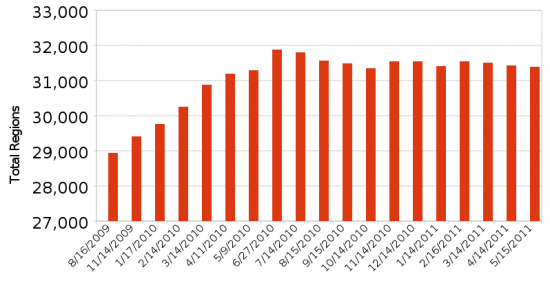
May Region Counts on the Top 40 Grids
We are now tracking a total of 144 different publicly-accessible grids, 80 of which reported their region counts this month. SpotOn3D did not report numbers for either the SpotOn3D or its Veesome grid.
The raw data for this month’s report is here.
- OSGrid: 7,583 regions
- Avination: 1,114 regions
- Virtual Worlds Grid: 890 regions
- InWorldz: 877 regions
- Kitely: 673 regions
- New World Grid: 659 regions
- AlphaTowne: 344 regions
- ScienceSim: 338 regions
- FrancoGrid: 332 regions
- Metropolis: 292 regions
- NexXtLife: 250 regions
- MyOpenGrid: 186 regions
- 3rd Rock Grid: 180 regions
- Craft World: 165 regions
- VirtualLife: 142 regions
- NZ Virtual World Grid: 129 regions
- ReactionGrid: 128 regions
- Gay Nations: 125 regions
- Virtyou: 122 regions
- SIM World: 99 regions
- Grid World: 93 regions
- Logicamp: 91 regions
- German Grid: 85 regions
- Slackdog Grid: 74 regions
- Open Neuland: 69 regions
- Twisted Sky: 69 regions
- Savage Grid: 67 regions
- SimValley: 60 regions
- Role Play Worlds: 57 regions
- Oasis World: 57 regions
- Annuna Grid: 57 regions
- Pseudospace: 53 regions
- Avatar Hangout: 53 regions
- Dorena’s World: 46 regions
- PMGrid: 40 regions
- GerGrid: 39 regions
- YourSimSpot: 35 regions
- Nova Grid: 34 regions
- NorthGrid: 30 regions
- UFS Grid: 28 regions
- OSgrid back online after extended maintenance - April 16, 2025
- Analysts predict drop in headset sales this year - March 25, 2025
- OSgrid enters immediate long-term maintenance - March 5, 2025
